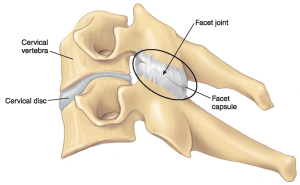We all take balance for granted.

Maintaining balance while standing in the stationary position relies on three major inputs:
- Joint position sense (proprioception).
- Inner ear
- Vision
Balance can be maintained if two of the three inputs are intact.
Romberg test is a neurological test to assess balance. The patient stands with their feet together and hands by their sides. Patient movement is then observed first with their eyes open and then with their eyes closed. Romberg test is positive when there is swaying or inability to stand erect when a patient’s eyes are closed.
A positive test, which suggests loss of proprioception, is commonly observed in patients with conditions affecting the dorsal columns of the spinal cord, conditions affecting sensory nerves( peripheral neuropathies), and injuries to the joints in the cervical spine that are rich in nerve fibers that convey joint position.
Cervical facet joints are commonly injured in motor accidents.

They are rich in fibers that provide us with spatial information. If you sustain an injury to your neck while skiing, kiteboarding or driving on the highway and have balance problems, remember the Romberg test and cervical facet damage.